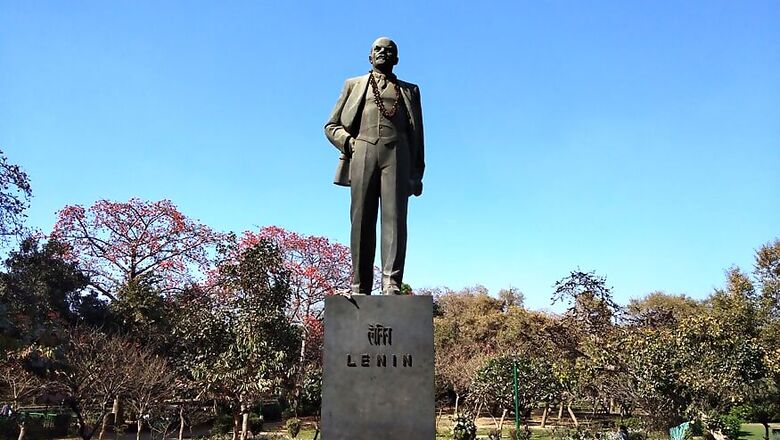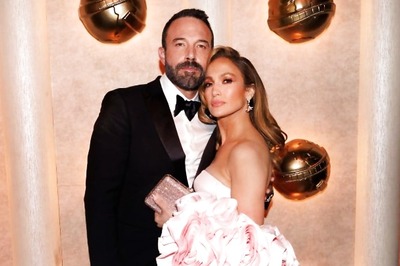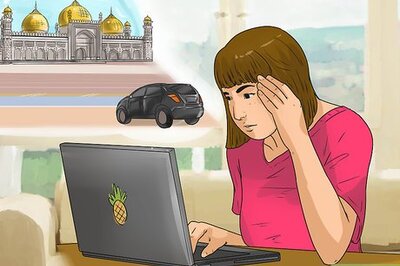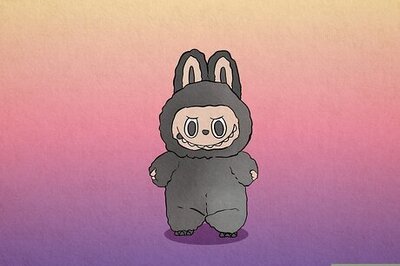
views
New Delhi: The Nehru Park in diplomatic enclave Chanakyapuri resembles the Mughal gardens around this time of the year. It is difficult to locate the solitary statue of Vladimir Lenin in this park, despite those in other parts of the country being in the eye of a storm.
Giving directions, Pawan Kumar, a tea vendor says, “There it is, the Nehru statue,” assuming that the sculpture was that of India’s first Prime Minister Jawaharlal Nehru, after whom the park is named.
The Soviet leader stands tall on a tiny hillock away from visitors' sight, near one of the exit gates, unperturbed by the imminent threat it faces in the current volatile atmosphere across the country and the Communist bastion Tripura, in particular.
Surrounded by red flowers and some greenery, the statue stands with its head held high and a hand in the pocket.
Meanwhile in Bengal, which has Lenin’s statues in abundance, the Mamata Banerjee government has deployed police teams to protect the Russian revolutionary’s statues.
On the other side, there is no plaque marking the inauguration of the one in Nehru Park. Only the name ‘Lenin’ is inscribed on the pedestal of the bronze statue, which is approximately 2.6 metres tall, leaving the rest to the imagination of an uninitiated visitor.
Vladimir Ilyich Lenin, born in 1870, was the leader of the Russian Revolution of 1917 and the first premier of the Soviet Russia and later the Soviet Union.
This statue at the Nehru Park was inaugurated in 1987 to mark the 70th anniversary of the October Revolution by then Indian Prime Minister Rajiv Gandhi and then Soviet Union Prime Minister Nikolai Ryzhov.
Even though the recent toppling of Lenin’s statues in Tripura has kicked up a massive debate, visitors at the park remain unaware of the statue. Ankita, a recent graduate who frequents the park since her childhood, said she has never noticed the statue until now.
However, for the maintenance staff, Lenin is the essence of the park. Sixty-year-old Babu Lal, the park’s gardener for the past 30 years said he was disappointed to see Lenin’s statues being toppled.
“The Russian leader’s statues shouldn’t be toppled as Russia is a good friend of India,” said Lal.
However, some see this ‘statue politics’ as unprecedented in Indian history and feel that it would be wrong to draw parallels between Lenin’s statue in Delhi and those in Tripura.
Pragati Mohapatra, a professor of Russian history and socialist politics at Indraprastha College for Women, says, “The Lenin statue in Delhi is just one the symbols of diplomatic relations in the capital, but in Tripura it gets a different context with the 25-year Left rule.”
“In Tripura, the BJP is reinterpreting history by attacking the visible symbols of the remnants of the past regime which it wants to replace.
“The BJP is asserting its new found empowerment in Tripura while in Delhi such an act would have no symbolic or ideological effect as the Left never ruled at the Centre,” added Mohapatra.
Others feel that people who support vandalising Lenin’s statues are misinterpreting history.
Rajan Kumar, who teaches at the Centre for Russian and Central Asian Studies at Jawaharlal Nehru University, said that Lenin had entered Indian political discourse even before the Independence and should not be associated with just the Left rule in India as during the 1920s, many socialist leaders and freedom fighters were influenced by Lenin’s ideas as he was anti-colonial.

















Comments
0 comment